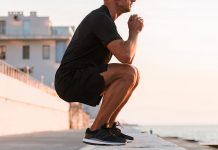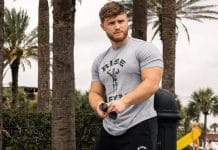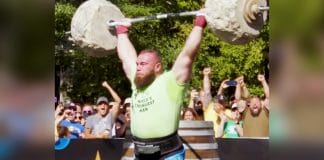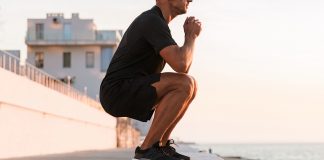
The Most Underrated Leg Exercise
You’ve been going to the gym for years. Your upper body looks alright, but your lower body looks like a malnourished fifth grader. Legs look like toothpicks and your butt is flatter than a pancake.
You’re frustrated with the scrawny legs not filling out your jeans, so you stop skipping leg day and start squatting your face off.
Now your legs are as sore as if a kickboxer nailed them with a few hundred kicks. But even with all this soreness, your lower body doesn’t grow much.
Rough dilemma ain’t it? Squats are great, but there are some common issues with squats that might be limiting your chopstick limbs from becoming tree trunks.
Issues With Squats
- Squats are highly affected by human anatomy. Depending on your hip structure and femur/tibia ratios, different squats won’t hit certain parts of your legs with enough stimulation. Potentially you could end up doing a squat variation that doesn’t pair well with your body structure. It’s also quite common for low back, core, or spinal fatigue to limit squat performance.
- You’ve grown accustomed to squats. Most guys squat all the time, but the human body likes to adapt. Something as simple as taking a break from squats and changing exercises might be what you need to grow your legs.
- Squats train both legs at the same time. This is problematic because one leg/glute tends to do more work while the weaker side gets neglected or becomes a limiting factor to how many reps you can do.
- Squats are technically hard. I don’t care how long you’ve been squatting, it’s actually one of the most technical exercises from head to toe. Most people’s form aren’t as good as they think.
Just because most guys do squats doesn’t mean you have to. You’re different, you not only clicked on this article to improve your ways, but you’ve read up to this point without clicking off even after I told you traditional squats might be limiting your growth, so I applaud you and your determined legs.
Now the exercise you probably need for your lower body muscles to expand like a hot air balloon are split squats. They’re effective, underrated, and you’ve probably been avoiding them because they also suck, but mechanically they should grow more muscle for a many people.
Below are a few different variations. For all of them keep a neutral spine, brace your core, and have a slight lean forward. The more vertical your front knee is, the more you’ll hit your glutes. As the knee travels forward, you will hit slightly more quads, so it’s up to you how you allow your knee to move. That being said, there’s nothing wrong with letting your knee travel past your toes. That’s a myth that doesn’t seem to vanish.
Anyways, a more forward lean will hit your glutes more while a more upright torso will hit your quads more. Hamstrings don’t really get trained with split squats, but they do contribute more than bilateral squats.
Your adductors also get some solid stimulation from spilt squats.
Regardless move steady and at a controlled forceful tempo on the way up and a slow and controlled tempo on the way down.
While there are many variations of split squats, they only differ in range of motion and weight placement. The general mechanics of all split squats are the same.
Split Squat Mechanics
- Start in a comfortable stance. Your feet should be on separate lines instead right behind each other like walking on a tight rope.
- Lower yourself as the front foot stays flat. The back heel should come up. You can tap your knee lightly on the ground or stop a bit short. I prefer the latter.
- Maintain stability and keep your hips neutral. Don’t let your knee collapse inwards. Let it track towards your toe naturally. If your knee goes past your toes, that’s perfectly fine as long as your front foot stays planted on the ground.
- As you come back up, be sure not to round your back. Keep your spine neutral.
DB Split Squat Guide
Goblet Split Squat Guide
Barbell Split Squat Guide
DB Bulgarian Split Squat Guide
Barbell Bulgarian Split Squat Guide
Front Foot Elevated Split Squat Guide
Benefits of Split Squats
Split squats allow you to train your legs unilaterally which helps with muscle and strength asymmetries and allow your nervous system to focus on one leg at a time. It’s arguably more natural too as you walk and move through daily life one leg at a time.
As for the main benefit you’re after, split squats will make your lower body look and feel epic. The strength gains are beastly and the muscle growth is powerful (yet painful). If you’re not used to them, you will likely be sore for a few days.
Lastly, they’re also great for various sport performance from cycling, soccer, sprinting, or even mixed martial arts.
That being said, they’re perfectly useful and still extremely beneficial for everyday population looking to stay fit and not allow their butts to sag as they approach 40 or 50.
Programming
To program these start by choosing a split squat variation. The Bulgarian and barbell variations will be harder, so I would avoid those if you’re a beginner. For your workout you can should do them for 5-12 reps per leg for 3-4 sets. If you do them as your main leg movement, do them at the beginning of the workout and use heavier loads. If you do them after doing your typical traditional squats, use slightly lighter loads and aim to knock out more reps.
Regardless be sure to add more weight or do more reps over time and the muscle tissue surrounding your booty and quads will explode in growth. You’ll fix the strength difference between legs, smash through a plateau, and have legs a centaur would be proud of.















